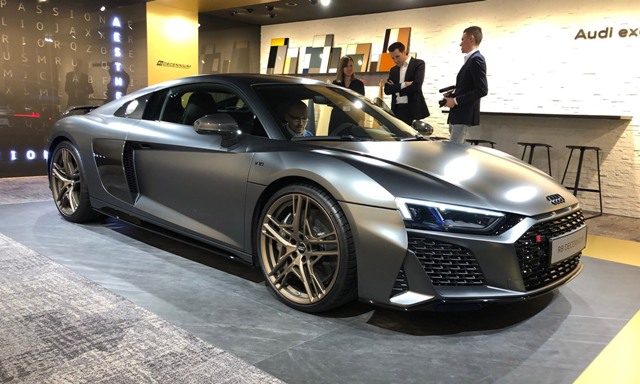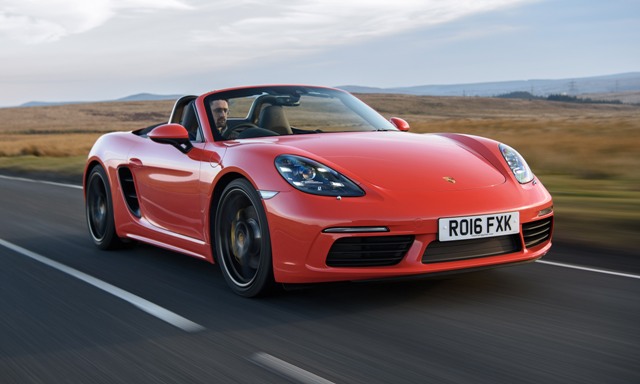Audi R8 With Aluminum Frame And Sports Racing Suspension
Almost as expected, the Audi R8 takes it bow into the supercar world, and it is a very worthwhile addition. Powered by a naturally aspirated 420 bhp V-8 in the latest version of Audi’s aluminum space frame and clothed in smart aluminum panels, the styling may not set the world alight and lacks the excitement of some supercars. Still it is a well balanced design.
With plenty of power in a compact and fairly light mid-engined coupe, the R8 is a true supercar: it has a top speed of 187 mph – no limiters here, I’m glad to say – and can sprint to 60 mph in 4.5 seconds, which is quicker than the Porsche 911 Carrera. Hmmm.
Almost as expected
Audi set the stage for the R8 supercar months ago, so we are not looking at a completely new shape, and you might think you have seen it all before, but not quite. So let’s start with the styling. The basic shape is based on the Le Mans concept car which we have all seen.
The Audi R8 is a bit like a scaled down and softened Bugatti Veyron not a bad image to have, and they are in the same group. Like the Veyron it does not have a very low swoopy nose, but retains quite high lamps and a distinctly
Audi grille. Thankfully, the grille is not as high as on the sedans, and has been flattened and stretched. Deep side air intakes give the car a purposeful look from the front.
Just a hint of fenders
There is just a hint of a fender at the front and the rear, while large side air intakes keep the engine compartment cool. Visually, the flow of the lines is broken up by dark panels behind the doors, which Audi thinks improves things, but spoil the lines. The coach roof is a typical fastback, merging into the tail where a pair of air outlets ape the front with their horizontal fins. Pretty smooth all round, and not marred by the spoiler which is concealed until you go fast enough to need it.
Inside you could be sitting in almost any other Audi. Plain leather, a wheel with a flat bottom section, and the usual plastic-looking fascia. Not really supercar stuff, but then some of the competition is not that brilliant in this respect.
Audi R8 super V-8 with direct injection
What you see is definitely not what you get, though. To start with Audi has souped up its 4.2 liter V-8, chucked the turbos away, and released plenty of power. This is the direct injection (FSI) version of the well-tried V-8, tuned up to 420 bhp at 7,800 rpm, with the red line at 8,250 rpm definitely well into Ferrari territory. Audi engineers have also spent a lot of effort getting plenty of mid-range torque to make the car driveable at all speeds, with 317 lb ft (430 Nm) torque available from 4,500 to 6,000 rpm.
Why no turbos? To start with turbo engines sound a bit flat and cannot compete with the roar from naturally aspirated units which also respond quicker without that turbo lag. Turbo lag is still there despite recent improvements.
In line with the trend in supercars, the engine has a dry sump system to ensure good lubrication even when cornering very fast.
Six-speeds and four-wheel drive
Mounted fore-and-aft, the V-8 is coupled as standard to a six-speed manual transaxle, driving through a quattro system to give four-wheel drive. This layout gives excellent weight distribution – 44 per cent front to 56 per cent rear.
As an option, there is the R tronic sequential shift gearbox with joystick and paddle control.
Audi R8 Aluminum space frame
All this power is tucked into an aluminum space frame made from extrusions and castings like the A8 and Lamborghini Gallardo which is a lot lighter than a steel structure would have been. Suspension is by double wishbones front and rear, and the power-assisted steering is hydraulic, despite the attractions of electric power on a mid-engined car.
Normally, the coil springs are mounted on conventional dampers, but there is the option of magneto-rheological dampers. These are used by Ferrari and offered on the Corvette, and offer an improved form of continuously variable damping.
Magneto-rheological dampers for better control
The damper fluid contains minute magnetic particles field. When a voltage is applied to these particles, they change the angles at which they lie, increasing resistance. This allows the damping to be set up to adjust to the contours of the road as it happens and also to iron out pitch and roll yet providing a good ride at lower speeds.
There are large 19-inch diameter wheels with double spoke alloy wheels – carrying 235/30 section front and 295/30 section rear tires. That is about as low a profile as you can get these days, so there is plenty of rubber in contact with the road.
All this goes together to make an exciting supercar with very rapid performance, the quattro system giving plenty of cornering power and stability.
But what about the weight? The aluminum space frame with aluminum panels should result in low weight, and the Audi R8 is not bad at 3,436 lb (1,560 kg). That is about the same as the Aston Martin V8 Vantage, despite the extra weight of the four-wheel drive system, and 240 lb more than the Ferrari F430.
It is also 286 lb (130 kg) more than the Lamborghini Gallardo, which has four-wheel drive and which is a little smaller than the Audi. So, the Audi engineers have done a pretty good job with the Audi R8 supercars. Welcome to the supercar ranks.




Comments
Post a Comment